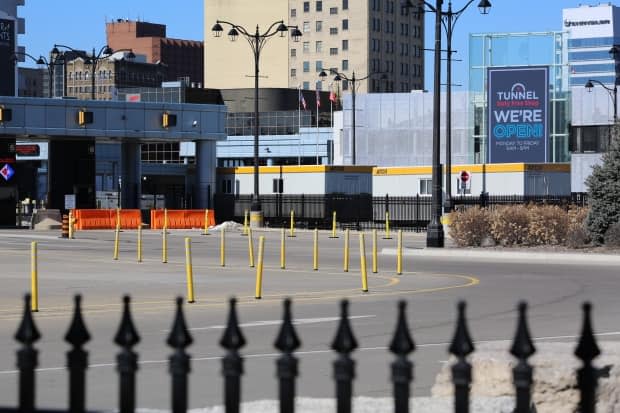COVID-19 testing rolls out for people entering Canada at 11 more land border crossings

Passengers entering Canada at 11 more border crossings will now have to give themselves a COVID-19 test as part of new entry requirements.
The new rules apply to non-essential travellers, who also have to present proof of a negative COVID-19 test taken in the last 72 hours and obey existing quarantine requirements.
The regulation was implemented at five land border crossings late last month and took effect at the 11 additional sites on Thursday.
They include the ports of entry in Windsor, Ont. — the Ambassador Bridge and the Detroit-Windsor Tunnel.
Randy Spader, general manager of the Ambassador Bridge, said there haven't been any issues so far on day one.
"Essential and truck traffic [is] free and clear," he said. "Usually see one or two vehicles in the PHAC [Public Health Agency of Canada] area, but running very smooth."
Trailers in the duty-free parking lots of both Windsor crossings, set up by the Public Health Agency of Canada and the Canadian Red Cross, are being used for the tests.

Melanie Soler, vice-president of emergency management response operations for the Canadian Red Cross, explained the process in an interview earlier this week.
Individuals who partake in on-site testing at the land border will be given two testing kits, she said.
The first kit will be self-administered by the traveller inside the testing trailer.
"Our personnel will observe them administering their own sample and packaging their own sample," Soler said.
"Once the traveller deposits that sample in a safe and sanitary spot, our personnel will put that in a refrigeration package to make sure it gets to the lab for testing."

It's not mandatory for individuals to be supervised by Red Cross staff when they self-administer their day one test, but the option is there in case they have any questions or need assistance, she added.
Traveller to use second test
In fact, a non-essential traveller can self-administer the swab in their personal quarantine location, if desired, according to PHAC.
The second test is supposed to be used on day 10 of the traveller's 14-day quarantine, and sent to be tested.
The new testing requirement is launching at the following ports of entry on Thursday:
Ambassador Bridge, Windsor, Ont.
The Peace Bridge in Fort Erie, Ont.
The Windsor-Detroit Tunnel
Blue Water Bridge in Sarnia, Ont.
Pacific Highway in B.C.
Niagara Falls Rainbow Bridge
Thousand Islands Bridge in Lansdowne, Ont.
St-Armand/Philipsburg, Que.
Huntingdon, B.C.
Emerson, Man.
Stanstead, Que.

